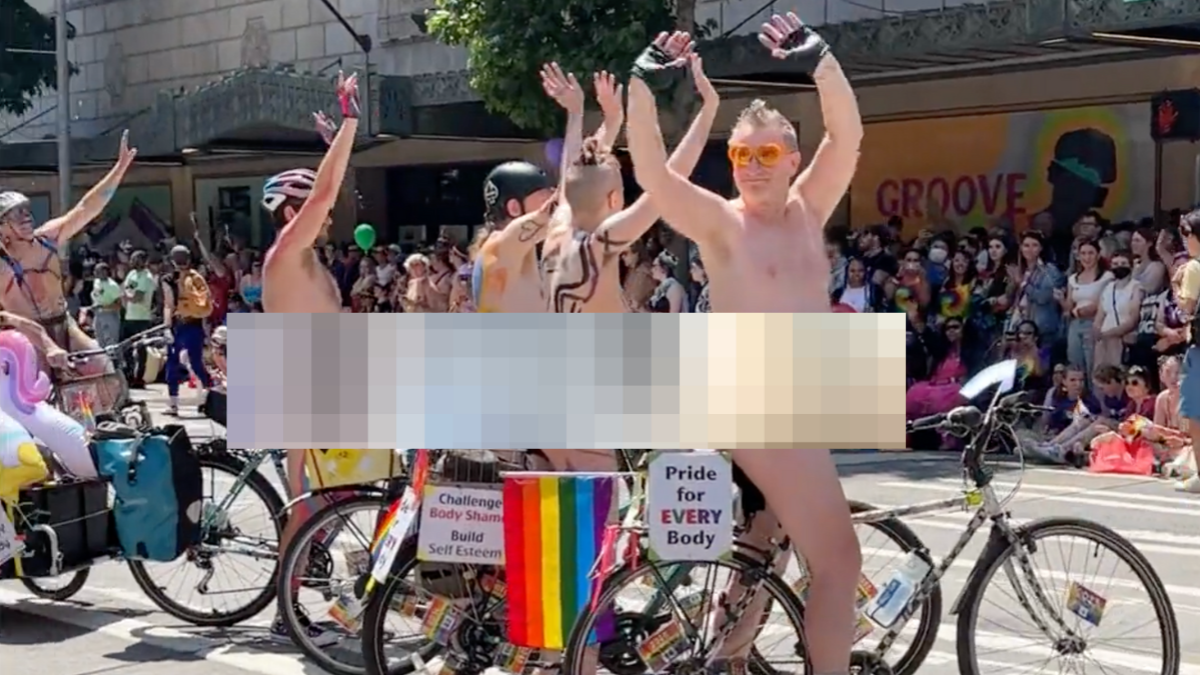
This article contains information and images not fit for children.
The Houston Public Library has apologized for featuring a convicted child molester last fall during its “Drag Queen Storytime” series. It has not, however, announced it will end the program that featured the male sex offender dressed up as a woman reading LGBT books to children as young as babies.
“A media spokesperson for the library confirmed one of the program’s drag queens, Tatiana Mala Nina, is Alberto Garza, a 32-year-old child sex offender,” reports local TV station KHOU. “In 2008, he was convicted of assaulting an 8-year-old boy.”
State records say the 200-pound, 5-foot-11 man was convicted of aggravated sexual assault of a child, is at a “moderate” risk for reoffending, and must report his whereabouts to police annually for the rest of his life. Garza’s YouTube channel showed he was in the process of transgendering himself, according to Rod Dreher (videos since removed; screenshot of Garza in drag captured here).
Drag Queen Storytime is spreading to libraries across the country, mostly but not exclusively in deeply Democratic locales. It even has a national PR webpage featuring an image of a scared toddler staring at a man dressed up in drag while the child’s mother encourages the child to get over the apprehension.
 Notice that this is the exact opposite of what sexual assault prevention programs teach people to do: pay attention to and act on their feelings of discomfort, rather than overrule them. Child molesters are known for “grooming” potential victims, including by getting them used to ignoring worries and warnings from their consciences, confusing them about what is normal, and accepting increasingly transgressive behavior.
Notice that this is the exact opposite of what sexual assault prevention programs teach people to do: pay attention to and act on their feelings of discomfort, rather than overrule them. Child molesters are known for “grooming” potential victims, including by getting them used to ignoring worries and warnings from their consciences, confusing them about what is normal, and accepting increasingly transgressive behavior.
Here are some snaps from the Drag Queen Storytime Instagram page. Determine for yourself whether what they depict might fit into the category of grooming.
View this post on Instagram
@ourladyofparadise plays the guitar at the @bcmkids reading this morning #dqsh #dragqueenstoryhour


View this post on Instagram
If you’re looking at this with a fair mind, it’s pretty easy to see that LGBT platitudes about “love” and “diversity” could malform children’s developing understanding of safe and appropriate sexual behavior. These platitudes have already been used to turn off the good judgment of the people who should be protecting children from potential harm, such as parents and librarians.
Five-Year-Olds Shouldn’t Be Learning About Anal Sex
Part of the problem is that it’s impossible to explain to a young child what “gay” or “transgender” is without also exposing her to concepts that are not appropriate for pre-pubescent children. It’s not true, for example, as the YouTube channel Queer Kids Stuff explains, that being gay just means: “When one person of one gender loves someone romantically who is the same gender. So, if a boy loves a boy, they’re gay. And if a girl loves a girl, they’re gay too. What if a person loves a person? They’re gay too.”
As everyone with any life experience knows, the vast majority of friendships among people of the same sex include no sexual activity or attraction. Women routinely love female relatives deeply with no sexuality involved, and the same is true for men. Emotional closeness does not suffice to define homosexuality, and telling kids it does risks teaching the falsehood that their childish affection for their best friend or father means they’re gay.
Gay people don’t look alike, act alike, have similar genetics or other biological characteristics, live exclusively near each other, or do (or be) any other thing that exclusively defines them as gay except for the type of sex they engage in. And prepubescent children simply are too young to be thinking about sex in the kind of specificity and detail required to explain that to them accurately.
They don’t need to know about oral or anal sex. They don’t need to know about men cutting off their penises and women cutting off their breasts to look more like the opposite sex. They shouldn’t be told damaging lies about how girls can have a boy’s body.
Until puberty, humans do not have biological sexual urges, and until that tandem physical and emotional maturation process begins, typically in middle school, it damages children’s moral, mental, and emotional development to expose them to these kinds of things. Some of these things should never be exposed or done to children, regardless of where they are in their sexual maturation.
7. Lungs "never fully inflate." Must use ventolin pump. pic.twitter.com/BXUfGJRya5
— 4thWaveNow (@4th_WaveNow) March 12, 2019
Early sexual exposure leads to many harms and risks, such as earlier and riskier sexual activity and vulnerability to predators. Showing pornography is an extreme example (that child predators also use), but on the danger spectrum is also the sexualization of our culture that typically feminists complain about. Little girls wearing booty shorts, taking children to movies with sex scenes, and tween boys demanding sexts are a part of this emotional brutalization, this dulling of conscience and eradication of innocence.
A sane culture would work to reduce children’s exposure to adult material. In a sane culture, it would not take an actual child molester leading Drag Queen Storytime to make people question the idea of such an event.
Queering the Curriculum Is a Thing That’s Happening
It’s not solely storytimes grooming children for sexual confusion, either, it’s also sex ed curricula in many schools. Because 2013’s Supreme Court decision Obergefell v. Hodges forcibly instituted genderless marriages into the nation’s legal regime, public schools are now legally bound to teach about gay sex in sex ed. That trickle-down is hitting blue and purple states and cities first, but it’s going to eventually be everywhere because the law demands treating gay and heterosexual sex as the same.
In Colorado, what that means is legislators drafting a mandate for “comprehensive sex ed” curriculum for all children in public schools ages 4-12. Four. Age four. What could four-year-olds be learning under this pending law? Well, the bill would mandate that children learn about “the relational or sexual experiences of lesbian, gay, bisexual or transgender individuals,” and “gender, gender expression, gender identity” — i.e., transgenderism. California and New York already have instituted such curricula in their public schools.
Many schools don’t need a mandate, however. Last November, a Colorado elementary school herded children from kindergarten through fifth grade into their auditorium to watch videos from the above-quoted Queer Kids Stuff YouTube channel. Accompanying lesson plans ask kids to write down what “gay” means after having watched the video explaining “gay” can mean “When a person loves a person.” If that’s the definition, we’re all gay. And if we’re all gay, gay doesn’t mean anything, and there’d be no need to teach it to four-year-olds.
Another lesson plan for another video asks kids to define “Bisexual” as “When a boy or girl loves other boys and girls,” and shows kids pictures of celebrities who label themselves bisexual. A later lesson tells kids to mark “False” at the statement “Doctors are always right when they say a new baby is a boy or girl.”
Schools also don’t need a sex ed class to teach children about adult sex topics starting at age four. Activists are working to embed LGBT material across classes. Just one example is A Queer Endeavor, a project of two education professors at the University of Colorado at Bolder that has taught about 5,000 teachers so far how to “integrate topics of gender and sexual diversity across program areas and teacher-preparation coursework.”
From Queering Classrooms to Queering Culture
One wonders whether there is any connection between queering classrooms and libraries and documented spikes in transgenderism among children, in both the United States and United Kingdom. Sociologist Mark Regnerus observes at First Things, “What had once comprised around 0.3 percent of the population as recently as 2011 has vaulted to 0.6 percent by 2016, with adolescent transgender self-identification comprising 0.7 percent. But a new study in Pediatrics, leaning on a statewide survey in Minnesota, revealed a figure just under 3 percent, four times as large as the Williams estimate. In other words, the adolescent transgender population has grown extraordinarily quickly.”
A recent Brown University study found that teens were more likely to identify as transgender if their peers and school culture were anti-heterosexual and heavy on identity politics. A cynic would wonder whether this is partially the point of these high-pressure social and legal campaigns.
Given that transgender identification is also related to trauma — about half the kids in the study who quickly identified as transgender had recently experienced significant emotional trauma, and of course it’s traumatic to cut off one’s healthy body parts and obsess over dildos in elementary school — this further reinforces the conclusion queering schools and storytimes doesn’t need to involve actual child molesters to pose a clear threat to children.
Another thriving Etsy storefront, TransPackingUniverse, sells handmade fabric prosthetic penises "Silly Willies" for very small children.https://t.co/K17ODWFDFl pic.twitter.com/SY4IJVc3zA
— 4thWaveNow (@4th_WaveNow) March 16, 2019









